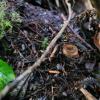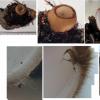
12-12-2025 18:39
Mirek GrycHello everyone.Macrofeatures similar to Mollisia b

09-12-2025 12:06
 Andgelo Mombert
Andgelo Mombert
Bonjour,Je recherche l'article concernant Hypobryo

07-12-2025 16:07
Arnold BüschlenHallo, ich habe in einer Moos-Aufsammlung (epiphy

08-12-2025 21:04
Mark Stevens"Hello everyone,I'm relatively new to microscopy (

08-12-2025 18:59
 Lothar Krieglsteiner
Lothar Krieglsteiner
.. found by a seminar-participant, I do not know t

08-12-2025 17:37
 Lothar Krieglsteiner
Lothar Krieglsteiner
20.6.25, on branch of Abies infected and thickened
Humaria hemisphaerica
B Shelbourne,
05-10-2024 15:55
• Confirmed by spores, etc.
• Hairs quite similar to Scutellinia.
Habitat: On mass of well rotten wood and roots, damp, with bryophytes, on the ground, under mature Salix caprea and Betula cf pendula, damp and shady area on an incline, above a pond, mixed deciduous woodland, Low Weald, England, early-October, after rain.
Apothecia: Two found around same piece of rotten wood but solitary, deeply cupulate but appear to flatten out from the margin (one deformed and broken by growing in a crevice), thin, sessile, partially immersed in the substrate, receptacle light brownish with dark brown hairs, hairs much denser and longer at the margin, mostly pointing inwards, appearing glazed or lightly gelatinised under low magnification, marginal hairs clumping together, disc greyish-white, dull, surface appears somewhat uneven in maturity, some anchoring hyphae noticeable under low magnification and retaining parts of the substrate.
Asci: Broadly cylindrical, IKI-, croziers, some look quite strange and extended, apex rounded, uniseriate, shrinking considerably when fully flaccid, some wrinkles visible.
Spores: ~19-21 x 11-12 um, most measured in asci as very few free spores found (perhaps due to immaturity), ellipsoid, homopolar, ends rounded to sub-truncate, in the asci developing two groups of small LBs at each pole, coalescing into two large LBs before discharge, +/- symmetric, fully ornamented with short warts of irregular size (easier to see in IKI), medium-density.
Paraphyses: Quite narrow, apparently exceeding the mature asci, apex always inflated, capitate to elongated-clavate, occasionally moniliform or mammiform, often with inflations at the septa close to the apex, sometimes appears like subapical narrowing, multi-septate, cell length seems quite variable, branching only observed close to the base, hyaline VBs?
Ectal: Textura prismatica-globosa?, cell size quite variable, some pigmented reddish-brown at the surface, associated to hairs.
Hairs: Scutellinia-like, brown, thick-walled, multi-septate, apex acute when developed, bases appear simple, tapering sharply, associaed with pigmentation in the ectal cells, with hyaline exudate, starting as short chains of large globose cells.
Medullary: Textura intricata, separated from ectal by a layer of horizontal hyphae.
Subhymenium: Difficult to distinguish from medullary.
Nicolas VAN VOOREN,
06-10-2024 09:04

Re : Humaria hemisphaerica
No problem, although this is a complex of species. Your collection might represent the original concept with rather short hairs.
The spore ornamentation is best seen in Cotton Blue.
The spore ornamentation is best seen in Cotton Blue.
B Shelbourne,
06-10-2024 19:07
Re : Humaria hemisphaerica
Thank you, I saw the brief discussion in the H. setimarginata paper but I didn't look into the subgroups any further. The taxon is historic, and when I found the apos then I was expecting the situation to be more similar to other Pezizales I've found.


 Sections-0007.jpeg
Sections-0007.jpeg